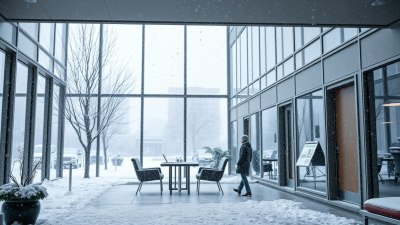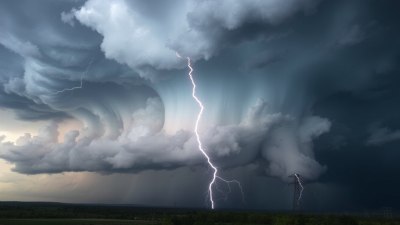Why Workplaces Turn Into Pressure Systems in Cold Weather
Explore how cold weather transforms workplaces into pressure systems affecting comfort, safety, and productivity.

Cold weather brings much more than just a chill in the air; it fundamentally changes the dynamics within workplaces. Many employees notice that buildings feel stuffy, doors become harder to open, and air movement inside seems unusual. These phenomena occur because workplaces effectively turn into pressure systems during cold weather. Understanding why this happens requires a look at how temperature influences air pressure, air flow, and building structure interactions.
The concept of pressure systems in workplaces revolves around differences in air pressure that develop between the inside and outside environments. During cold weather, the air temperature outside drops considerably, causing the air to become denser and heavier. Meanwhile, heating systems inside maintain a warmer indoor temperature, which makes the indoor air lighter and less dense. This temperature difference leads to pressure imbalances that impact how air moves through the workplace.
One of the most visible signs of these pressure systems is door operation. Employees often find that certain doors are more difficult to open or close during colder months. This difficulty arises because the pressure difference between the inside and outside creates a force either pushing the door closed or holding it open. For example, warmer indoor air exerts higher pressure compared to the cold outdoor air, forcing doors shut when attempting to open from inside.
Pressure systems within buildings are not just a nuisance. They have significant implications for comfort and energy efficiency. When the pressure inside is higher than outside, warm air can be pushed out through small cracks and seams in the building envelope. This exfiltration increases heating demands and reduces overall comfort. Conversely, if the pressure inside is lower, cold air can infiltrate the space, causing drafts and uneven temperatures.
Another critical aspect is the stack effect, a natural phenomenon amplified in tall buildings during cold weather. Warm air inside rises due to its lower density, escaping through upper floors or roof openings, while cold outside air enters at lower levels. This vertical movement of air creates strong pressure differences that impact ventilation and heating efforts. In this way, workplaces become complex pressure systems with dynamic airflows influenced by temperature extremes.
These pressure differences can also affect indoor air quality. For instance, unintended air infiltration brings in outdoor pollutants and allergens, which can reduce air quality inside. At the same time, higher pressure inside can push conditioned air out, leading to wasted energy and reduced humidity control. Managing these pressure systems is therefore essential for maintaining a healthy indoor environment during cold weather.
To address pressure imbalances, many workplaces implement controlled ventilation systems. These systems use fans, dampers, and airlocks to balance indoor and outdoor air pressures, reducing unwanted drafts and preventing air leakage. Properly designed HVAC (heating, ventilation, and air conditioning) can mitigate the impact of cold weather pressure effects, improving both comfort and energy usage.
Building envelope design is equally crucial. Proper insulation, sealing of gaps, and use of pressure barriers create a tighter building shell that resists air pressure differences. This prevents cold air from sneaking in and warm air from escaping, maintaining a more stable indoor environment. During renovations, adding storm doors or vestibules can help create buffer zones that ease the pressure gradient faced when moving between indoors and outdoors.
Employee behavior also plays a role in managing pressure effects. For example, keeping doors closed as much as possible reduces the direct exchange of air and the associated pressure shifts. Training staff to recognize these issues and report problematic doors or drafty areas contributes to overall workplace comfort. Simple fixes like installing door sweeps or weather stripping can further help equalize pressures and reduce cold air infiltration.
In industrial or warehouse settings, pressure systems are even more critical. These large spaces often have massive doors and ventilation challenges that cold weather intensifies. Pressure differentials can make doors hard to operate or cause sudden gusts of air that disrupt work or create safety hazards. Understanding and managing pressure systems in these contexts ensures productivity and compliance with health and safety regulations.
Additionally, the interaction of pressure systems with heating systems matters. For example, radiant heaters, forced-air systems, and heat pumps all interact differently with indoor airflows. Forced-air systems circulate air, which can increase pressure changes if not balanced properly. Radiant heating, which warms surfaces without moving much air, reduces these effects but requires careful consideration of building pressure balance to maintain comfort.
Humidity levels are also influenced by these pressure systems. Cold outdoor air holds less moisture, so when it leaks indoors due to pressure imbalances, it can reduce indoor humidity, causing discomfort like dry skin and respiratory irritation. Maintaining balanced pressure helps keep indoor humidity at comfortable levels, important for both health and building material preservation.
In summary, workplaces turn into pressure systems during cold weather because of temperature-driven differences in air density and pressure. These differences lead to air movement that affects door operation, comfort, air quality, energy use, and safety. Addressing the challenges requires a combination of proper building design, mechanical systems, and occupant behavior. Understanding how pressure systems function is key to creating workplaces that remain comfortable, efficient, and safe regardless of weather extremes.
Investing in pressure management technologies and practices not only reduces heating costs but also extends the lifespan of building infrastructure. By minimizing air leaks and controlling airflow, maintenance costs decrease, and unexpected drafts or moisture issues are avoided. This proactive approach to handling pressure systems is increasingly important as energy codes tighten and workplaces seek sustainable operations.
The role of smart building technologies is also growing in this area. Sensors that monitor indoor air pressure, temperature, and humidity allow facility managers to detect pressure imbalances quickly. Automated ventilation adjustments respond to these signals, maintaining optimal conditions without manual intervention. Over time, such systems contribute to improved occupant well-being and lower environmental footprints.
Finally, education and awareness about pressure systems can foster cooperation between management and employees. When staff understand why doors behave differently or why certain areas feel drafty in winter, they are more likely to follow practices that help balance pressures and improve the environment. Communication, combined with technical solutions, creates resilient workplaces ready to face the challenges of cold weather.











